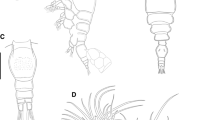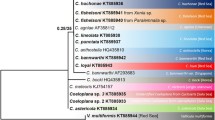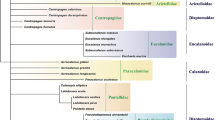Abstract
The discrimination of species of the copepod genus, Calanus (Copepoda; Calanoida), is problematical-especially in regions of sympatry. Although the species of Calanus exhibit exceptional morphological similarity, they are quite distinct in genetic character. The DNA base sequences of the mitochondrial large subunit (16S) ribosomal RNA (rRNA) gene unambiguously discriminated C. finmarchicus (Gunnerus 1765), C. glacialis (Jaschnov 1955), C. marshallae (Frost 1974), C. helgolandicus (Claus 1863), C. pacificus (Brodsky 1948), C. sinicus (Brodsky 1965), and C. hyperboreus (Kroyer 1838). Sequence differences among Calanus species for this gene portion range from 7.3% (between C. glacialis and C. marshallae) to 23.9% (between C. glacialis and C. sinicus). Differences among conspecific individuals were approximately 1 to 2%. [These sequence data were determined between April and November 1993; the sequenced domain is similar to that published previously in Bucklin et al. (1992) but are derived from analysis of additional individuals.] Statistical analysis of the sequence data using a variety of tree-building algorithms separated the taxa into one group of species corresponding to the C. finmarchicus group (C. finmarchicus, C. marshallae, and C. glacialis) and another ungrouped set of species corresponding to the C. helgolandicus group (C. helgolandicus, C. pacificus, and C. sinicus). The C. helgolandicus group may be older than the C. finmarchicus group, making the tree topology less reliable in this area. Calanus hyperboreus was an outlier; Nannocalanus minor (Claus 1863) was the outgroup. Similar analysis of Metridia species confirmed that M. lucens (Boeck 1864) and M. pacifica (Brodsky 1948) are distinct species; M. longa (Lubbock 1854) was still more divergent. These sequence data will allow the design of simple, molecular tools for taxonomic identifications. Diagnostic characters, assayed by rapid molecular protocols, will enable biological oceanographers to answer important questions about the distribution and abundance of all life stages (as well as patterns of reproduction) of morphologically similar species, such as those of Calanus.
Similar content being viewed by others
References
Alldredge AL, Robison BH, Fleminger A, Torres JJ, King JM, Hamner WM (1984) Direct sampling and in situ observation of a persistent copepod aggregation in the mesopelagic zone of the Santa Barbara Basin. Mar Biol 80:75–81
Avise JC, Arnold J, Ball RM, Bermingham E, Lamb T, Neigel JE, Reeb CA, Saunders NC (1987) Intraspecific phylogeography: the mitochondrial DNA bridge between population genetics and systematics. A Rev Ecol Syst 18:489–522
Avise JC, Gibling-Davidson C, Laerm J, Patton JC, Lansman RA (1979) Mitochondiral DNA clones and matriarchal phylogeny within and among geographic populations of the pocket gopher, Geomys pinetis. Proc natn Acad Sci USA 76:6694–6698
Ayala FJ, Tracy ML, Barr LG, MacDonald JF, Perez-Salas S (1974) Genetic variation in natural populations of five Drosophila species and the hypothesis of the selective neutrality of protein polymorphisms. Genetics 77:343–348
Birky CW, Fuerst P, Maruyama T (1989) Organelle gene diversity under migration, mutation, and drift: equilibrium expectations, approach to equilibrium, effects of heteroplasmic cells, and comparison to nuclear genes. Genetics 121:613–627
Bradford JM (1988) Review of the taxonomy of the Calanidae (Copepoda) and the limits to the genus Calanus. Hydrobiologia 167/168:73–81
Bradford JM, Jillette JB (1974) A revision of generic definitions in the Calanidae (Copepoda, Calanoida). Crustaceana 27:5–16
Brasher DJ, Ovenden JR, White RWG (1992) Mitochondiral DNA variation and phylogenetic relationships of Jasus spp. (Decapoda: Palinuridae). J Zool Lond 227:1–16
Brodsky KA (1948) Free living Copepoda of the Sea of Japan. Izv tikhookean n auch no-issled Inst ryb Khoz Okeanogr 26:3–130
Brodsky KA (1965) Variability and systematics of the species of the genus Calanus (Copepoda). I Calanus pacificus Brodsky, 1948 and C. sinicus Brodsky, sp n. Issled Fauny Morei 3:22–71 (in Russian)
Brodsky KA (1967a) Formation of swimming limbs in the genus Calanus (Copepoda) and latitudinal zonality. Dokl Akad Nauk SSSR 176:1441–1444 (in Russian)
Brodsky KA (1967b) Types of female genitalia and heterogeneity in the genus Calanus (Copepoda). Dokl Akad Nauk SSSR 176: 222–225 (in Russian)
Brodsky KA (1972) Phylogeny of the fam. Calanidae (Copepoda) on the basis of comparative-morphological analysis of its characters. Issled Fauny Morei 12:1–110 (in Russian)
Bucklin A, Frost BW, Kocher TD (1992) DNA sequence variation of the mitochondrial 16S rRNA in Calanus (Copepoda; Calanoida): intraspecific and interspecific patterns. Molec mar Biol Biotechnol 1:397–407
Bucklin A, LaJeunesse TC (1994) Molecular genetic variation of Calanus pacificus (Copepoda; Calanoida): preliminary evaluation of genetic structure and sub-specific differentiation based on mtDNA sequences. Calif coop ocean Fish Invest Rep 35:45–51
Clary DO, Wolstenholme DR (1985) The mitochondrial DNA molecule of Drosophila yakuba: nucleotide sequence, gene organization, and genetic code. J molec Evolut 22:252–271
Cox JL, Willason S, Harding L (1983) Consequences of distributional heterogeneity of Calanus pacificus grazing. Bull mar Sci 33:213–226
Cunningham CW, Blackstone NW, Buss LW (1992) Evolution of king crabs from hermit crab ancestors. Nature, Lond 355: 539–542
DeDecker AHB, Kaczmaruk BZ, Marska G (1991) A new species of Calanus (Copepoda, Calanoida) from South African waters. Ann S Afr Mus 101:27–44
Devereux J, Haeberli P, Smithies O (1984) A comprehensie set of sequence analysis programs for the VAX. Nucleic Acids Res 12:387–395
Ehrlich HH, Bugawan TL (1990) HLA DNA typing. In: Innis MA, Gelfand DH, Sninsky JJ, White TJ (eds) PCR protocols: a guide to methods and applications. Academic Press, San Diego, pp 261–271
Feng D-F, Doolittle RF (1987) Progressive sequence alignment as a prerequisite to correct phylogenetic trees. J molec Evolut 25: 351–360
Fleminger A (1964) Distributional atlas of calanoid copepods in the California Current region, Part I. Calif coop ocean Fish Invest Atlas 2:1–213
Fleminger A (1985) Dimorphism and possible sex change in copepods of the family Calanidae. Mar Biol 88:273–294
Fleminger A, Hulsemann K (1977) Geographical range and taxomonic divergence in North Atlantic Calanus (C. helgolandicus, C. finmarchicus, and C. glacialis). Mar Biol 40:233–248
Fleminger A, Hulsemann K (1987) Geographical variation in Calanus helgolandicus s.1. (Copepoda, Calanoida) and evidence of recent speciation of the Black Sea population. Biol Oceanogr (NY) 5:43–81
Frost BW (1974) Taxonomic status of Calanus finmarchicus and C. glacialis (Copepoda), with special reference to adult males. J Fish Res Bd Can 28:23–30
Frost BW (1974) Calanus marshallae, a new species of calanoid copepod closely allied to the sibling species C. finmarchicus and C. glacialis. Mar Biol 26:77–99
Grainger EH (1961) The copepods Calanus glacialis and Calanus finmarchicus (Gunnerus) in Canadian Arctic-Subarctic waters. J Fish Res Bd Can 18:663–678
Hulsemann K (1991) Calanus euxinus, new name, a replacement name for Calanus ponticus Karavaev, 1894 (Copepoda: Calanoida). Proc biol Soc Wash 104:620–621
Jaschnov WA (1955) Morphology, distribution, and systematics of Calanus finmarchicus s. l. Zool Zh 34:1210–1223 (in Russian)
Jaschnov WA (1957) Comparative morphology of the species Calanus finmarchicuss.l. Zool Rh 36:191–198 (in Russian)
Kumar S, Tamura K, Nei M (1993) MEGA: molecular evolutionary genetics analysis, Version 1.0. Pennsylvania State University, University Park, Pennsylvania
Machado EG, Dennebouy N, Suarez MO, Mounolou J-C, Monnerot M (1992) Mitochondrial 16S rRNA gene of two species of shrimps: sequence variability and secondary structure. Crustaceana 65:279–286
Palumbi SR, Benzie J (1991) Large mitochondrial DNA differences between morphologically similar Penaeid shrimp. Molec mar Biol Biotechnol 1:27–34
Palumbi S, Martin A, Romano S,McMillan WO, Stice L, Grabowski G (1991) The simple fool's guide to PCR (Ver. 2) (unpublished manuscript)
Saitou N, Nei M (1987). The neighbor-joining method: a new method for reconstructing phylogenetic tree. Molec Biol Evolut 4:406–425
Sherman K, Smith WG, Green JR, Cohen E, Berman MS, Marti KA, Goulet JR (1987) Zooplankton production and fisheries of the northeast shelf. In: Backus RH, Bourne DW (eds) Georges Bank. MIT Press, Cambridge, Massachusetts, pp 268–282
Skjoldal HR, Rey F (1989) Pelagic production and variability of the Barents Sea ecosystem. In: Sherman K, Alexander LM (eds) Biomass yields and geography of large marine ecosystems. AAAS Publ, Washington DC, pp 241–286
Smith LM, Sanders JZ, Kaiser RJ (1986) Fluorescence detection in automated DNA sequence analysis. Nature, Lond 321:674–679
Smithies O, Engles WR, Devereaux JR, Slightom JL, Shen S (1981) Base substitutions, length differences and DNA strand asymmetries in the human G-gamma and A-gamma fetal globin gene region. Cell 26:345–353
Stoneking M, Hedgecock D, Higuchi RG, Vigilant L, Erlich HA (1991) Population variation of human mitochondrial DNA control region sequences detected by enzymatic amplification and sequence-specific oligonucleotide probes. Am J Genet 48: 370–382
Swofford DL (1991) PAUP: phylogenetic analysis using parsimony, Version 3.0q. Illinois Natural History Survey, Champaign, Illinois
Tamura K, Nei M (1993) Estimation of the number of nucleotide substitutions in the control region of mitochondrial DNA in humans and chimpanzees. Mol Biol Evolut 10:512–526
Wilson AC, Cann RL, Carr SM, George M, Gyllensten UB, Helm-Bychowski KM Higuchi RG, Palumbi SR, Proger EM, Sage RD, Stoneking M (1985) Mitochondrial DNA and two perspectives on evolutionary genetics. Biol J Linn Soc 26:375–400
Xiong B, Kocher TD (1991) Comparison of mitochondrial DNA sequences of seven morphospecies of black flies (Diptera: Simuliidae). Genome 34:306–311
Author information
Authors and Affiliations
Additional information
Communicated by J. P. Grassle, New Brunswick
Rights and permissions
About this article
Cite this article
Bucklin, A., Frost, B.W. & Kocher, T.D. Molecular systematics of six Calanus and three Metridia species (Calanoida: Copepoda). Marine Biology 121, 655–664 (1995). https://doi.org/10.1007/BF00349301
Received:
Accepted:
Issue Date:
DOI: https://doi.org/10.1007/BF00349301




